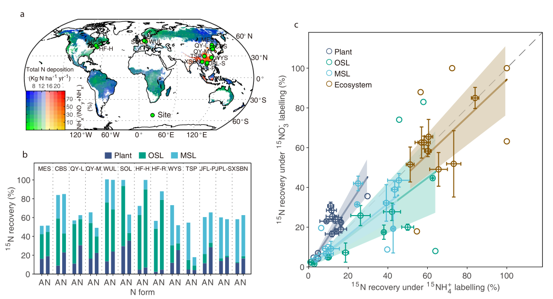
High emissions of reactive nitrogen (N) by human activities have increased global N deposition. Given that most natural ecosystems are historically N-limited, increased N deposition is thought to enhance forest plant productivity and thereby to increase carbon (C) sink. This has been widely considered as the environmental befit of N deposition that contributes to the mitigation of global warming.
The impacts of deposited N on forest ecosystems depend on its fates, i.e., its retention in biomass and soil organic matter pools versus its losses via leaching and nitrogenous gases. The fates of deposited N are also expected to differ depending on whether it is in reduced (mainly as ammonium) or oxidized (mainly as nitrate) form. Thus, the key to estimate forest C sink due to N deposition is to quantify the fate of deposited ammonium and nitrate.
To date, many studies have examined the fate of deposited N to forest ecosystems by adding 15N tracers, but most of them are small in scale and short in time. In addition, spatial heterogeneities in the total and form of deposited N across forest biomes increase difficulties in making reliable global estimates of the contribution of N deposition to C sink. These uncertainties hamper prediction of the effects of increased N availability in the biosphere on C balance and its implication for global climate change mitigation.
To address the problems outlined above, Prof. FANG Yunting's team at the Institute of Applied Ecology of the Chinese Academy of Sciences (CAS), in collaboration with the scientists at home and abroad, initiated a Chinese forest ecosystem 15N tracer network.
Based on the results in nine ecosystem-scale paired 15N-tracer experiments from China and four earlier studies in temperate forests in the US and Europe, the researchers have conducted an investigation on the fate of atmospheric N deposited ammonium and nitrate into forests and their contribution to forest C sinks.
They showed that about 70% of 15N tracers was retained in the forests and total ecosystem 15N retention was similar between ammonium and nitrate. But the utilization rate of nitrate was higher than that of ammonium.
Based on the 15N-tracer-derived N retention in plant and soil pools and using a stoichiometric upscaling approach, they further estimated a global forest C sink due to N deposition in 2010s at 0.72 Pg C yr-1, which was higher than previously reported estimates. This new estimate suggested that about 20% of the annual global terrestrial C sink over the last decade might be due to N deposition.
These findings contribute to improved understanding of the effects of N deposition on C and N cycling in forest ecosystems globally and suggest that N deposition is an important contribution factor to forest C sink.
Results have been published online on Nature Communications on February 15.
This work was financially supported by the National Key Research and Development Program of China, the Key Research Program of Frontier Sciences of CAS, the National Natural Science Foundation of China, the National Research Program for Key Issues in Air Pollution Control, and the K. C. Wong Education Foundation.

Global distribution of total N deposition in forests and locations of the 13 paired 15N-labelling experimental sites (a); Percent recoveries in plants, organic soil layer and mineral soil for deposited N at the 13 paired 15N-labelling sites (b); Relationship between 15N recovery for 15NH4+ tracer and 15NO3- tracer (c). (Image by WANG Ang)

Comparison of atmospheric N deposition and its contribution to global forest C sink in different studies. (Image by WANG Ang)

86-10-68597521 (day)
86-10-68597289 (night)

86-10-68511095 (day)
86-10-68512458 (night)

cas_en@cas.cn

52 Sanlihe Rd., Xicheng District,
Beijing, China (100864)

